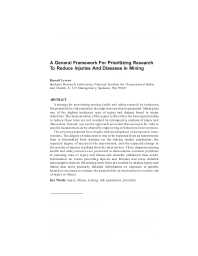Mining Publication: A General Framework for Prioritizing Research To Reduce Injuries and Diseases in Mining
Original creation date: December 1998
A strategy for prioritizing mining health and safety research by evaluating the potential for risk reduction through intervention is proposed. Mining has one of the highest incidence rates of injury and disease found in major industries. The main premise of this paper is that often the best opportunities to reduce these rates are not revealed by retrospective analysis of injury and illness data. Instead, a proactive approach is needed that accounts for risks to specific hazards that can be abated by engineering or behavioral interventions. The process proposed here begins with development of prospective interventions. The degree of reduction in risk to be expected from an intervention then is determined from statistics on the mining worker population, the expected degree of success on the intervention, and the expected change in the severity of injuries resulting from the intervention. Three disparate mining health and safety concerns are presented to demonstrate common problems in assessing risks of injury and illness and describe additional data needs. Information on events preceding injuries and illnesses and more detailed demographic data on the mining work force are needed to analyze injury and illness data more precisely. Detailed information on exposure to specific hazards is necessary to evaluate the potential for an intervention to reduce risk of injury or illness.
Authors: RL Levens
Peer Reviewed Journal Article - December 1998
NIOSHTIC2 Number: 20000180
Hum Ecol Risk Assess 1998 Dec: 4(6):1285-1290
See Also
- Analysis of Health and Safety Management System Practices Through Multilevel Interventions
- An Analysis of Roof Bolter Fatalities and Injuries in U.S. Mining
- Current Knowledge of U.S. Metal and Nonmetal Miner Health: Current and Potential Data Sources for Analysis of Miner Health Status
- Injuries, Illnesses, and Hazardous Exposures in the Mining Industry, 1986-1995: A Surveillance Report
- Machine Injury Prediction by Simulation Using Human Models
- Mining Facts for 2000
- Practical Risk Assessment Guidelines for Identifying, Assessing, and Mitigating Stored Energy Hazards in Underground Coal Mines During and After a Mine Emergency
- SPONCOM - A Computer Program for the Prediction of the Spontaneous Combustion Potential of an Underground Coal Mine
- SponCom - Spontaneous Combustion Assessment Software - 2.0
- Technology News 545 - NIOSH Updates Spontaneous Combustion Assessment Software
- Content source: National Institute for Occupational Safety and Health, Mining Program


 ShareCompartir
ShareCompartir
